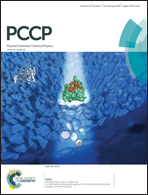The unimolecular chemistry of [Zn(amino acid)2-H]+ in the gas phase: H2 elimination when the amino acid is a secondary amine†
Abstract
The unimolecular chemistry of the [Zn(Pro-H)(Pro)]+ complex following collisional or infrared multiple photon activation was studied, and interestingly was found to lose H2 as one of the main dissociation pathways. Furthermore a second dehydrogenation step, forming [Zn(Pro-H)(Pro)-2H2]+, was also observed. When proline was substituted for sarcosine, also a secondary amine, a single dehydrogenation was observed. In contrast, [Zn(Gly-H)(Gly)]+ and [Zn(Ala-H)(Ala)]+ were found to lose H2O as their primary fragmentation route with no dehydrogenation observed. Tandem mass spectrometry, deuterium substitution, and infrared spectroscopy were used to determine the origin of the H atoms in the losses of H2, as well as for other fragmentation routes, including the loss of H2O. The hydrogen atoms for H2 loss from [Zn(Pro-H)(Pro)]+ was found to originate on the amine group and primarily from C5 on the non-deprotonated proline, with a smaller contribution from the C2 hydrogen. Both hydrogens for H2O loss were determined to be from labile hydrogens. Potential energy surfaces were computed for the H2 loss and H2O loss routes for both [Zn(Pro-H)(Pro)]+ and [Zn(Gly-H)(Gly)]+ and were compared. For [Zn(Pro-H)(Pro)]+, H2 loss was found to be the pathway with the lower energy requirement than for H2O loss, and the opposite was found for [Zn(Gly-H)(Gly)]+. The greater basicities of proline and sarcosine are most likely responsible for stabilizing the 3 coordinate Zn2+ transition states en route to H2 loss, compared to those complexes formed with the much less basic glycine or alanine.
![Graphical abstract: The unimolecular chemistry of [Zn(amino acid)2-H]+ in the gas phase: H2 elimination when the amino acid is a secondary amine](/en/Image/Get?imageInfo.ImageType=GA&imageInfo.ImageIdentifier.ManuscriptID=C3CP53716A&imageInfo.ImageIdentifier.Year=2014)

 Please wait while we load your content...
Please wait while we load your content...